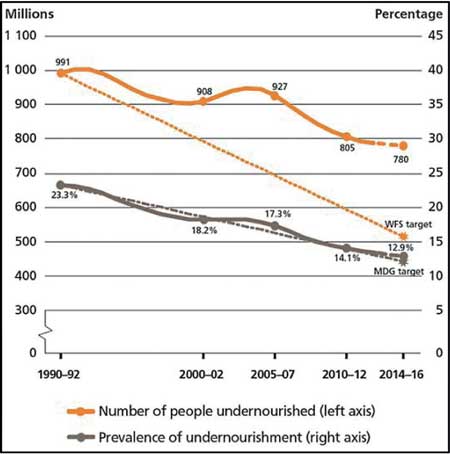Wednesday Mar 19, 2025
Wednesday Mar 19, 2025
Friday, 5 June 2015 00:00 - - {{hitsCtrl.values.hits}}

Global hunger has continued to decline, gradually, to an estimated 795 million undernourished people, or a reduction of 167 million hungry people over the last 10 years according to the latest edition of the annual UN hunger report, The State of Food Insecurity in the World 2015 (SOFI).
This decline has been most pronounced in developing countries, despite significant population growth. The report is published by the Food and Agriculture Organization of the United Nations (FAO), the International Fund for Agricultural Development (IFAD) and the World Food Programme (WFP).
The year 2015 is a milestone, marking the end of the Millennium Development Goal (MDG) monitoring period. For the developing regions as a whole, the target to reduce the proportion of the world’s hungry by 50% by 2015 was missed by a small margin.
Zero Hunger
“The near-achievement of the MDG hunger targets shows us that we can indeed eliminate the scourge of hunger in our lifetime. We must be the Zero Hunger generation. That goal should be mainstreamed into all policy interventions and at the heart of the new sustainable development agenda to be established this year,” said FAO Director General, José Graziano da Silva.
During the past quarter century, of all regions in the world, the Asia and the Pacific region has achieved the fastest rate of economic growth, leading to a dramatic reduction in extreme poverty below $ 1.25/person/day and meeting, in early 2010, the Millennium Development Goal of reducing the proportion of people living in extreme poverty by half.
The region also achieved the largest reduction in the number of undernourished people in the world, and the region as a whole achieved the MDG 1c target of reducing the proportion of people who suffer from hunger by half by 2015.

Sri Lanka
While Sri Lanka has made progress, it has however yet to achieve the MDG 1c target. The proportion of undernourished in Sri Lanka stands at 22.0% in 2014-16, down from 30.6% in 1990-92.
“The report is proof that we can win the fight against hunger and should be inspiring to move forward. We are motivated to see the credible findings of the report on the decline of hunger levels in Sri Lanka and also globally,” said Ismail Omer, Representative, WFP Sri Lanka.
“The State of Food Insecurity in the World report shows that hunger has been decreasing in Sri Lanka, but there is more to be done to address hunger—including malnutrition—so as to ensure food and nutrition security are sustained for the most vulnerable.”
The challenge of ensuring food security can only be met if all stakeholders work together, with a multi-sectoral outlook. Economic growth is a key success factor for reducing undernourishment, but it has to be inclusive and provide opportunities for improving the livelihoods of the poor.
“Hunger and food insecurity are often an access problem, caused by lack of purchasing power, lack of physical access or lack of social protection schemes,” said Beth Crawford, FAO Representative for Sri Lanka and the Maldives. “The challenge, therefore, is not only increasing food production and availability to meet the growing demand, but also ensuring continual access to nutritious and diverse food.”
“In order to meet the challenge of complete eradication of food and nutrition insecurity, particularly at household level, that is still visible in many economically lagging areas in Sri Lanka, efforts should be made to achieve inclusive economic growth,” flagged Anura Herath, IFAD Country Programme Officer for Sri Lanka and the Maldives. In that effort, both targeted investment in rural people and continuous monitoring of their malnutrition level, especially that of children would be essential.
Discover Kapruka, the leading online shopping platform in Sri Lanka, where you can conveniently send Gifts and Flowers to your loved ones for any event including Valentine ’s Day. Explore a wide range of popular Shopping Categories on Kapruka, including Toys, Groceries, Electronics, Birthday Cakes, Fruits, Chocolates, Flower Bouquets, Clothing, Watches, Lingerie, Gift Sets and Jewellery. Also if you’re interested in selling with Kapruka, Partner Central by Kapruka is the best solution to start with. Moreover, through Kapruka Global Shop, you can also enjoy the convenience of purchasing products from renowned platforms like Amazon and eBay and have them delivered to Sri Lanka.
Discover Kapruka, the leading online shopping platform in Sri Lanka, where you can conveniently send Gifts and Flowers to your loved ones for any event including Valentine ’s Day. Explore a wide range of popular Shopping Categories on Kapruka, including Toys, Groceries, Electronics, Birthday Cakes, Fruits, Chocolates, Flower Bouquets, Clothing, Watches, Lingerie, Gift Sets and Jewellery. Also if you’re interested in selling with Kapruka, Partner Central by Kapruka is the best solution to start with. Moreover, through Kapruka Global Shop, you can also enjoy the convenience of purchasing products from renowned platforms like Amazon and eBay and have them delivered to Sri Lanka.